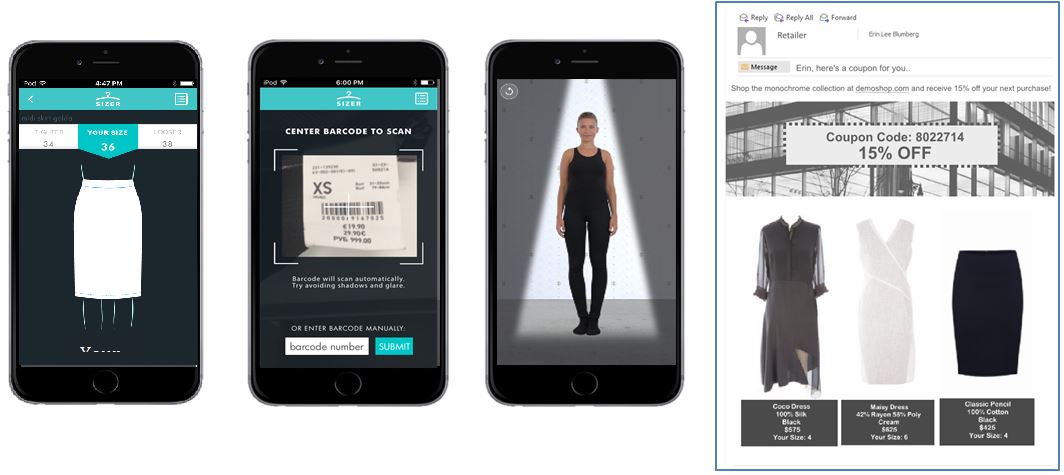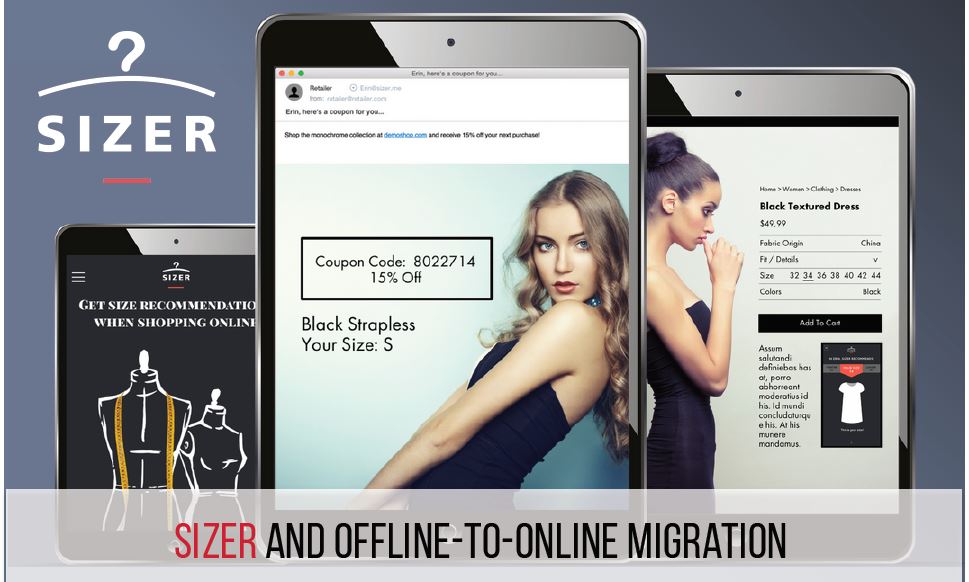
A few months ago, we profiled two firms that are trying to solve the problem of finding the perfect-fitting garment when shopping online—True Fit and Fits.me. Here, we return to this subject to look at a third innovator, Sizer.
Unlike True Fit and Fits.me, which target reduced return rates for apparel, Sizer seeks to help apparel retailers provide a personalized shopping experience and drive Internet sales. The company says its take on return rates is different: it claims that if a retailer “knows how to sell on a personal level,” then returns will decrease as a result.
Like True Fit and Fits.me, Sizer is a third-party service that enables retailers to help online shoppers find the clothes that fit them best. However, Sizer also enables shoppers to find the best fit in physical stores. The company’s body-scanning technology relies on computer vision algorithms to capture body measurements with great accuracy, and it operates on apps for the iPhone and iPad. The matching system technology allows retailers, in turn, to make size and fit recommendations based on a customer’s measurements.
Sizer’s matching system is based on key parameters such as garment measurement, type of fabric, elasticity and the vision of the designer. So, its recommendations are based on both garment specifications and the customer’s body measurements, as opposed to the customer’s measurements alone.
DEMAND FOR A BETTER FIT OFFLINE AND ONLINE
Internet retail sales constitute nearly one-fifth of all fashion sales in mature e-commerce markets. Store-based retailers must tap this channel, convincingly, in order to compete with pure-play behemoths.
But online is a channel that comes with added expenses, notably the cost of returns. For multi-channel fashion retailers, 15%–20% of online purchases are typically returned. Low conversion rates are another drawback of selling online. On average, only around 2% of those who browse online go on to buy a product. Fitting-tech solutions can help with each of these elements, and different tech companies emphasize different benefits.
HOW SIZER WORKS
Sizer says its value proposition is to enable retailers to offer more personalized and immersive shopping experiences both in-store and at home.
What Consumers Experience
Sizer aims to give consumers greater confidence that they are buying the right fit when shopping for apparel. Shoppers can be scanned in-store or they can scan themselves at home using the Sizer app, in order to have their measurements recorded. Users need set up only one profile, including just a single scan of themselves, in order to get recommendations from retailers that use the technology.
In-Store:
- Shoppers scan themselves in-store, and create their personal profile.
- They can then receive personalized recommendations and in-store offers via staff iPads.
- When shoppers return to the store, they can scan the barcode of items that they like, and receive a personal fit recommendation via smartphone.
At Home:
- Shoppers download the Sizer app and use it to scan their body shape. Alternatively, they can scan themselves in-store at selected retailers.
- Sizer generates a body-measurement profile and uses it to make recommendations when customers shop online or in-store.
- When a user is logged in to Sizer, those online retailers that feature the Sizer widget can recommend the ideal size and fit of garments for that shopper, as well as push personalized offers to the shopper.
- Each user can also view a “personal wardrobe” on a retailer’s site that shows garments that fit him or her best.
- Users need to set up only a single profile, including just one scan of themselves, in order to get recommendations from retailers that use the technology.

WHAT ARE THE BENEFITS TO RETAILERS?
As we noted in our previous fit-tech report, when shoppers have greater confidence that they are choosing the right product, it can boost online conversion rates, helping a retailer’s top line. And a more accurate fit drives down return rates, too, bolstering the retailer’s bottom line.
Sizer says that it can help in-store customers buy with more confidence from the same retailer online. The company is focusing on monobrand retailers that have complete data on their garment fits and that want to grow their sales on the Internet, where multibrand retailers, from Amazon to Zalando, are exceptionally strong.
Retailers benefit from the data that Sizer collects on body shapes and fits. At the end of the scanning process, the user fills in his or her personal information (such as name, email, date of birth and sex), creating a body profile. That body profile is then shared with partner retailers, immediately enhancing their online databases of omni-channel customer information.
The company delivers Big Data reports to its retail clients, giving them information about the body shapes and fitting requirements of their customers, as well as data on failed purchases due to a lack of availability of fit. These reports can then inform apparel retailers’ design and buying decisions.
ONLINE-TO-OFFLINE INNOVATION

Helped by new technologies, personalized advice and information are moving from online to in-store, as we noted in our recent report entitled
Personalization in Retailing: A Digital Solution for Each Shopper. Sizer is one contributor to this wave of tech-driven, in-store and at-home personalization.
The ability to get recommendations in-store when scanning a product barcode brings the type of data consumers are used to seeing on websites into physical shops. There is likely to be considerably less demand for fitting advice in-store, as shoppers can try garments on there. But this solution is part of the wave of technologies—which includes elements such as beacons—that are set to make the in-store experience more tech-enabled, and more integrated with online shopping.
WHO IS USING SIZER?
As noted earlier, the company is focusing on monobrand clients. This is in large part because those retailers tend to have comprehensive data on the dimensions and fitting styles of their garments. Mass-market multibrand retailers that are shipping apparel items through fast and changing their offerings frequently are likely to find it tougher to compile this kind of data across their ranges.
However, Sizer says a large multibrand online retailer in Asia has recently deployed its solution, with Sizer developing a seamless method for retrieving the technical specifications for the variety of brands on the retailer’s website.
The company told us that many monobrand retailers are finding they need to provide a more personalized online offering and leverage their in-store traffic in order to grow their online sales.


 A few months ago, we profiled two firms that are trying to solve the problem of finding the perfect-fitting garment when shopping online—True Fit and Fits.me. Here, we return to this subject to look at a third innovator, Sizer.
Unlike True Fit and Fits.me, which target reduced return rates for apparel, Sizer seeks to help apparel retailers provide a personalized shopping experience and drive Internet sales. The company says its take on return rates is different: it claims that if a retailer “knows how to sell on a personal level,” then returns will decrease as a result.
Like True Fit and Fits.me, Sizer is a third-party service that enables retailers to help online shoppers find the clothes that fit them best. However, Sizer also enables shoppers to find the best fit in physical stores. The company’s body-scanning technology relies on computer vision algorithms to capture body measurements with great accuracy, and it operates on apps for the iPhone and iPad. The matching system technology allows retailers, in turn, to make size and fit recommendations based on a customer’s measurements.
Sizer’s matching system is based on key parameters such as garment measurement, type of fabric, elasticity and the vision of the designer. So, its recommendations are based on both garment specifications and the customer’s body measurements, as opposed to the customer’s measurements alone.
A few months ago, we profiled two firms that are trying to solve the problem of finding the perfect-fitting garment when shopping online—True Fit and Fits.me. Here, we return to this subject to look at a third innovator, Sizer.
Unlike True Fit and Fits.me, which target reduced return rates for apparel, Sizer seeks to help apparel retailers provide a personalized shopping experience and drive Internet sales. The company says its take on return rates is different: it claims that if a retailer “knows how to sell on a personal level,” then returns will decrease as a result.
Like True Fit and Fits.me, Sizer is a third-party service that enables retailers to help online shoppers find the clothes that fit them best. However, Sizer also enables shoppers to find the best fit in physical stores. The company’s body-scanning technology relies on computer vision algorithms to capture body measurements with great accuracy, and it operates on apps for the iPhone and iPad. The matching system technology allows retailers, in turn, to make size and fit recommendations based on a customer’s measurements.
Sizer’s matching system is based on key parameters such as garment measurement, type of fabric, elasticity and the vision of the designer. So, its recommendations are based on both garment specifications and the customer’s body measurements, as opposed to the customer’s measurements alone.

 Helped by new technologies, personalized advice and information are moving from online to in-store, as we noted in our recent report entitled Personalization in Retailing: A Digital Solution for Each Shopper. Sizer is one contributor to this wave of tech-driven, in-store and at-home personalization.
The ability to get recommendations in-store when scanning a product barcode brings the type of data consumers are used to seeing on websites into physical shops. There is likely to be considerably less demand for fitting advice in-store, as shoppers can try garments on there. But this solution is part of the wave of technologies—which includes elements such as beacons—that are set to make the in-store experience more tech-enabled, and more integrated with online shopping.
Helped by new technologies, personalized advice and information are moving from online to in-store, as we noted in our recent report entitled Personalization in Retailing: A Digital Solution for Each Shopper. Sizer is one contributor to this wave of tech-driven, in-store and at-home personalization.
The ability to get recommendations in-store when scanning a product barcode brings the type of data consumers are used to seeing on websites into physical shops. There is likely to be considerably less demand for fitting advice in-store, as shoppers can try garments on there. But this solution is part of the wave of technologies—which includes elements such as beacons—that are set to make the in-store experience more tech-enabled, and more integrated with online shopping.
